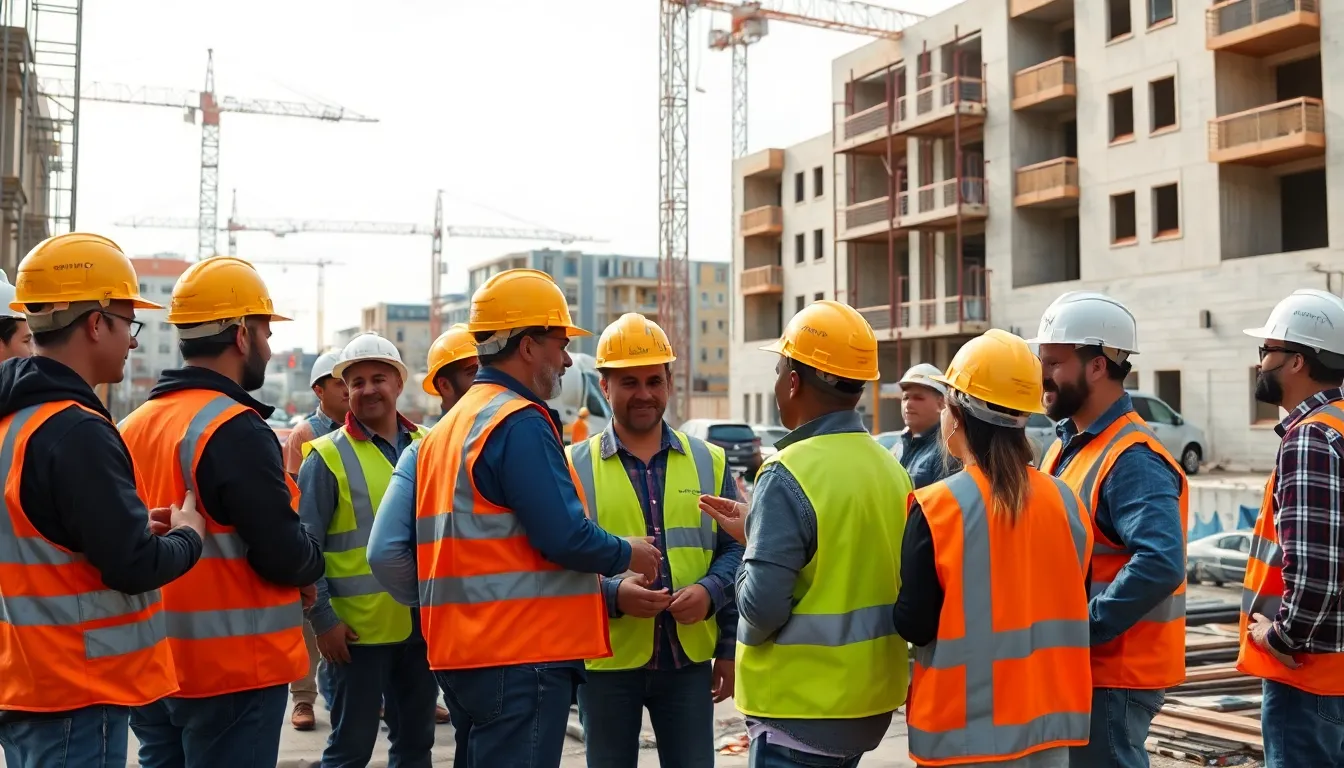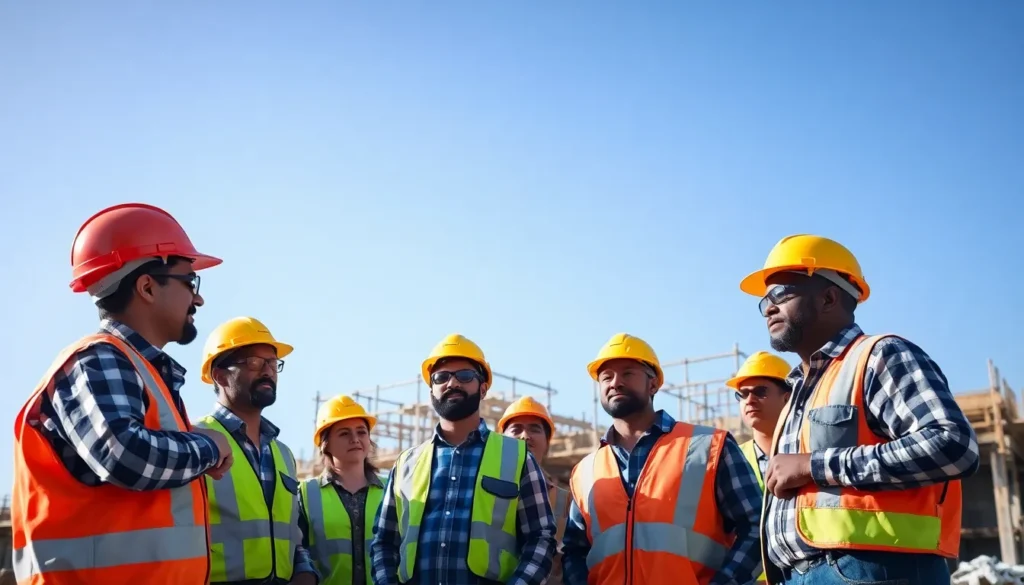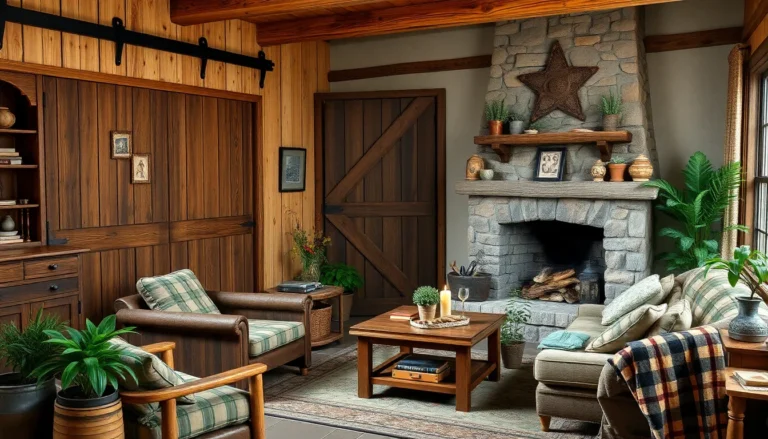Table of Contents
ToggleIn a world where skyscrapers reach for the clouds and cozy homes hug the earth, construction building stands as the backbone of modern society. It’s not just about bricks and mortar; it’s about creating spaces where dreams come alive. From the grandest structures to the tiniest nooks, every project tells a story of vision, craftsmanship, and a dash of chaos—because let’s face it, every builder knows that a little mayhem is part of the fun.
Whether it’s a sleek office building or a charming cottage, construction is where art meets science. It’s about turning blueprints into reality while dodging unexpected rain showers and the occasional rogue squirrel. So grab your hard hat and join the adventure, because the world of construction is as thrilling as it is essential. Who knew that building could be this entertaining?
Overview of Construction Building
Construction building serves as the backbone of infrastructure and economic development. It encompasses various activities that involve design, planning, and execution. Projects can range from residential homes to large commercial facilities. Each project requires collaboration between architects, engineers, and contractors to bring visions to life.
Sustainability remains a key focus in modern construction. Many builders prioritize eco-friendly materials and energy-efficient designs. Incorporating green technologies reduces the environmental impact of structures. Industry standards are evolving, with an increasing emphasis on sustainable practices.
Safety is paramount on construction sites. Compliance with local regulations and safety protocols protects workers from hazards. Regular training ensures that everyone understands proper safety procedures. Implementing advanced safety measures minimizes accidents and promotes a culture of awareness.
Technological advancements significantly influence construction techniques. Innovations like Building Information Modeling (BIM) enhance project visualization and collaboration. Drones monitor site progress while 3D printing streamlines component fabrication. Such technologies improve efficiency and reduce costs.
Challenges remain throughout the construction process. Weather fluctuations can delay timelines and affect material delivery. Ensuring quality control requires constant monitoring and adjustment. Open communication among team members is essential to navigate these challenges.
Investment in the construction industry signals economic growth. Increased construction activity contributes to job creation and stimulates local economies. Each building serves as a testament to human ingenuity and creativity. Engaging in diverse projects fosters cultural enrichment within communities.
Types of Construction Building

Several types of construction buildings cater to diverse needs within the industry, each serving unique purposes and functionalities.
Residential Construction
Residential construction encompasses single-family homes, townhouses, and condominiums. Developers focus on creating living spaces that reflect personal tastes and meet community standards. Builders prioritize energy efficiency with eco-friendly materials, enhancing sustainability in housing. Planning plays a critical role in navigating zoning laws and ensuring compliance with local regulations. This type of construction often involves collaboration with architects and homeowners, aiming to create vibrant neighborhoods that foster a sense of community.
Commercial Construction
Commercial construction includes office buildings, retail spaces, and shopping centers. This sector aims to create functional environments that meet the demands of businesses and their customers. Successful projects integrate aesthetic appeal with practical layouts, reflecting the brand’s identity. Key considerations revolve around safety standards and accessibility, ensuring compliance with necessary regulations. Contractors often work closely with business owners to understand specific needs, thereby crafting commercial spaces that enhance productivity and customer engagement.
Industrial Construction
Industrial construction targets manufacturing facilities, warehouses, and distribution centers. This type prioritizes durability and efficiency in design, accommodating heavy machinery and large-scale operations. Design and layout significantly impact workflow and productivity, with builders focusing on optimizing space for functional use. Compliance with environmental regulations remains critical in this sector, influencing material selection and energy standards. Collaboration with engineers and industry experts is vital to deliver facilities that support robust industrial processes and sustainability initiatives.
Key Materials in Construction Building
Construction relies heavily on various key materials, each serving distinct purposes while contributing to the structural integrity and aesthetics of buildings.
Concrete
Concrete stands as one of the most utilized construction materials worldwide. It combines cement, water, sand, and gravel to form a durable and strong substance. This material frequently serves as the foundation for many structures, ensuring stability and longevity. Varied types of concrete mix, such as reinforced or pre-stressed, enhance its properties based on specific project requirements. Notably, concrete’s versatility allows for various applications, including floors, walls, and decorative features in residential and commercial settings.
Steel
Steel plays a pivotal role in modern construction due to its strength and flexibility. Used primarily in beams, reinforcements, and framing, it supports vertical loads while resisting lateral forces. Builders often favor structural steel for high-rise buildings and bridges, given its ability to bear significant weight without compromising safety. The material can be pre-fabricated, streamlining construction processes and reducing on-site labor. Moreover, steel’s recyclability aligns with sustainability initiatives, promoting eco-friendly practices in modern construction projects.
Wood
Wood serves as a traditional yet essential material in construction, revered for its natural aesthetic and ease of use. Commonly selected for framing, roofing, and flooring, it provides insulation, balancing energy efficiency with style. Various types of wood, such as softwood for structural uses and hardwood for finishes, enhance the visual appeal of any project. Additionally, innovative treatments strengthen wood, making it more resistant to moisture, pests, and decay, thereby extending its lifespan. The push for sustainability boosts the popularity of engineered wood products, promoting responsible forestry practices in the industry.
Innovations in Construction Building
Innovations in construction building enhance efficiency and sustainability across the sector. Key developments shape the way projects are envisioned and executed.
Sustainable Practices
Sustainable practices gain traction, focusing on eco-friendly materials and energy-efficient designs. Builders increasingly prioritize solar energy integration, reducing dependence on traditional power sources. Rainwater harvesting systems capture natural resources for reuse. Employing recycled materials, like reclaimed wood and repurposed steel, minimizes waste and promotes responsible forestry. Net-zero energy buildings emerge as a standard, achieving balance between energy consumption and production. Prefabrication techniques streamline construction timelines and lessen material waste. Achievements in reducing the carbon footprint reflect growing environmental awareness among construction professionals.
Technology and Automation
Technology and automation transform industry practices, leading to significant productivity improvements. Building Information Modeling (BIM) supports collaborative design, allowing stakeholders to visualize projects before construction begins. Drones survey job sites, ensuring accurate measurements and identifying potential issues without manual labor. Robotics assist in repetitive tasks, enhancing safety and efficiency on-site. Advanced project management software simplifies communication among team members, reducing delays and miscommunications. 3D printing introduces innovative construction methods, significantly shortening the time needed to create complex structures. Integration of these technologies shapes the future of construction, driving advancements and new possibilities.
Challenges in Construction Building
Construction building faces significant challenges impacting project completion and quality. Addressing these issues is vital to ensure successful outcomes.
Regulatory Issues
Regulatory issues pose complex hurdles for construction projects. Compliance with local, state, and federal regulations is essential. Permitting processes can cause delays, requiring thorough documentation and adherence to safety standards. Zoning laws can complicate site selection, often impacting project design. Navigating these regulations demands expertise, as failure to comply can lead to costly fines and legal complications.
Labor Shortages
Labor shortages significantly affect the construction industry. A lack of skilled workers hampers project timelines and quality. Many construction trades, including carpentry, plumbing, and electrical work, experience acute shortages. Young people often overlook careers in construction, leading to an aging workforce. Attracting new talent requires industry efforts to promote job training programs and apprenticeship opportunities, facilitating a skilled labor pipeline.
The construction industry stands as a testament to human ingenuity and resilience. It combines creativity with practicality to shape the environments where people live and work. As challenges arise, the sector continues to evolve through innovation and collaboration, ensuring projects meet modern demands.
Sustainability remains a driving force, pushing builders to adopt eco-friendly practices that benefit both the planet and future generations. With advancements in technology and a focus on safety, the industry is poised for a bright future.
Ultimately, construction is not just about erecting buildings; it’s about building communities and creating spaces that inspire and endure.








